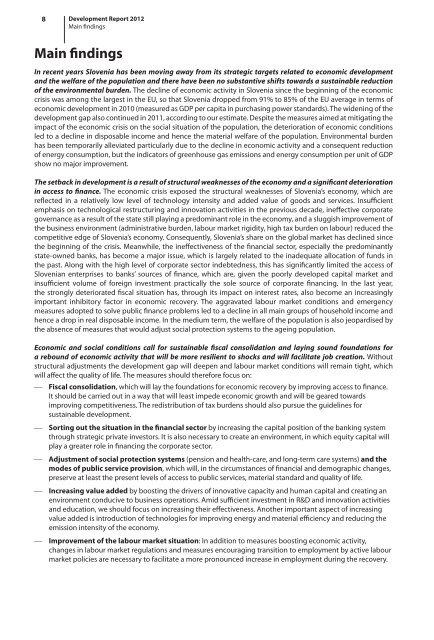development report 2012 - UMAR
development report 2012 - UMAR
development report 2012 - UMAR
You also want an ePaper? Increase the reach of your titles
YUMPU automatically turns print PDFs into web optimized ePapers that Google loves.
8 Development Report <strong>2012</strong><br />
Main findings<br />
Main findings<br />
In recent years Slovenia has been moving away from its strategic targets related to economic <strong>development</strong><br />
and the welfare of the population and there have been no substantive shifts towards a sustainable reduction<br />
of the environmental burden. The decline of economic activity in Slovenia since the beginning of the economic<br />
crisis was among the largest in the EU, so that Slovenia dropped from 91% to 85% of the EU average in terms of<br />
economic <strong>development</strong> in 2010 (measured as GDP per capita in purchasing power standards). The widening of the<br />
<strong>development</strong> gap also continued in 2011, according to our estimate. Despite the measures aimed at mitigating the<br />
impact of the economic crisis on the social situation of the population, the deterioration of economic conditions<br />
led to a decline in disposable income and hence the material welfare of the population. Environmental burden<br />
has been temporarily alleviated particularly due to the decline in economic activity and a consequent reduction<br />
of energy consumption, but the indicators of greenhouse gas emissions and energy consumption per unit of GDP<br />
show no major improvement.<br />
The setback in <strong>development</strong> is a result of structural weaknesses of the economy and a significant deterioration<br />
in access to finance. The economic crisis exposed the structural weaknesses of Slovenia’s economy, which are<br />
reflected in a relatively low level of technology intensity and added value of goods and services. Insufficient<br />
emphasis on technological restructuring and innovation activities in the previous decade, ineffective corporate<br />
governance as a result of the state still playing a predominant role in the economy, and a sluggish improvement of<br />
the business environment (administrative burden, labour market rigidity, high tax burden on labour) reduced the<br />
competitive edge of Slovenia’s economy. Consequently, Slovenia’s share on the global market has declined since<br />
the beginning of the crisis. Meanwhile, the ineffectiveness of the financial sector, especially the predominantly<br />
state-owned banks, has become a major issue, which is largely related to the inadequate allocation of funds in<br />
the past. Along with the high level of corporate sector indebtedness, this has significantly limited the access of<br />
Slovenian enterprises to banks’ sources of finance, which are, given the poorly developed capital market and<br />
insufficient volume of foreign investment practically the sole source of corporate financing. In the last year,<br />
the strongly deteriorated fiscal situation has, through its impact on interest rates, also become an increasingly<br />
important inhibitory factor in economic recovery. The aggravated labour market conditions and emergency<br />
measures adopted to solve public finance problems led to a decline in all main groups of household income and<br />
hence a drop in real disposable income. In the medium term, the welfare of the population is also jeopardised by<br />
the absence of measures that would adjust social protection systems to the ageing population.<br />
Economic and social conditions call for sustainable fiscal consolidation and laying sound foundations for<br />
a rebound of economic activity that will be more resilient to shocks and will facilitate job creation. Without<br />
structural adjustments the <strong>development</strong> gap will deepen and labour market conditions will remain tight, which<br />
will affect the quality of life. The measures should therefore focus on:<br />
⎯ Fiscal consolidation, which will lay the foundations for economic recovery by improving access to finance.<br />
It should be carried out in a way that will least impede economic growth and will be geared towards<br />
improving competitiveness. The redistribution of tax burdens should also pursue the guidelines for<br />
sustainable <strong>development</strong>.<br />
⎯ Sorting out the situation in the financial sector by increasing the capital position of the banking system<br />
through strategic private investors. It is also necessary to create an environment, in which equity capital will<br />
play a greater role in financing the corporate sector.<br />
⎯ Adjustment of social protection systems (pension and health-care, and long-term care systems) and the<br />
modes of public service provision, which will, in the circumstances of financial and demographic changes,<br />
preserve at least the present levels of access to public services, material standard and quality of life.<br />
⎯ Increasing value added by boosting the drivers of innovative capacity and human capital and creating an<br />
environment conducive to business operations. Amid sufficient investment in R&D and innovation activities<br />
and education, we should focus on increasing their effectiveness. Another important aspect of increasing<br />
value added is introduction of technologies for improving energy and material efficiency and reducing the<br />
emission intensity of the economy.<br />
⎯ Improvement of the labour market situation: In addition to measures boosting economic activity,<br />
changes in labour market regulations and measures encouraging transition to employment by active labour<br />
market policies are necessary to facilitate a more pronounced increase in employment during the recovery.
















